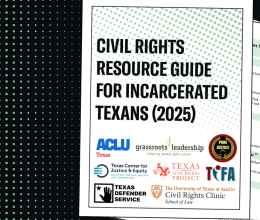
A Solitary Failure: The Waste, Cost and Harm of Solitary Confinement in Texas
The Texas Department of Criminal Justice (TDCJ) confines 4.4 percent of its prison population in solitary confinement. Texas locks more people in solitary-confinement cells than twelve states house in their entire prison system. On average, prisoners remain in solitary confinement for almost four years; over one hundred Texas prisoners have spent more than twenty years in solitary confinement. The conditions in which these people live impose such severe deprivations that they leave prison mentally damaged; as a group, people released from solitary are more likely to commit more new crimes than people released from the rest of the prison system. Yet in 2013, TDCJ released 1,243 people directly from solitary-confinement cells into Texas communities. These prisoners return to society after living for years or decades in a tiny cell for twenty-two hours a day, with no contact with other human beings or access to educational or rehabilitative programs. As documented in our report, A Solitary Failure: The Waste, Cost and Harm of Solitary Confinement in Texas, this dangerous and expensive practice is making our state less safe.
Here’s a summary of the report, which explains why less solitary confinement is not about going “soft” on crime, it’s about being smart on crime.
- Background - Explore the the early failure of solitary confinement, the misguided return of solitary confinement int he late 20th century, and the renewed consensus: solitary is a dangerous and expensive correctional practice.
- Solitary Confinement increases crime - Solitary permanently damages people who will one day return to Texas communities. The consequences of overusing solitary is more crime in Texas communities.
- Solitary is a huge cost to taxpayers - Solitary confinement costs Texas taxpayers at leas $46 Million a year.
- Overuse of solitary increases prison violence – Solitary confinement makes prison less safe and deprives officers of the option to incentivize good behavior. Violence escalates when officers deny people in solitary basic needs. Other states have improved prison safety by reducing solitary confinement.
- Mentally ill people deteriorate - The universal consensus: never place the seriously mentally ill in solitary. Yet, Texas sends thousands of people with mental illnesses to solitary confinement and inadequately monitors and treats them.
A Solitary Failure: The Waste, Cost and Harm of Solitary Confinement in Texas was researched and written by Burke Butler, Arthur Liman Fellow, TCRP, and Matthew Simpson, Policy Strategist, ACLU of Texas, and edited by Rebecca L. Robertson, Legal and Policy Director, ACLU of Texas.
“Everyday from dusk to dawn theres noise, banging, clanking, yelling, screaming. Everyday someone is getting hurt or hurting themselves. Everyday theres fire and floods and complete chaos & hate. Everyday there’s loneliness. I woke up last night to someone screaming ‘Let Me Out of Here’ (again) over and over with so much anguish there was no doubt he was screaming from his very soul. But he was just screaming what we are all thinking. Everyday is a challenge here. A challenge against insanity.”
-Alex
Documents
Related content


ACLU of Texas Responds to State Officials’ Attacks on Nonprofits
November 19, 2025
Why Police Traffic Stops Are Dangerous and Ineffective
October 30, 2025
Advocating for Your Rights Behind Bars: How to Use Our Civil Rights...
August 15, 2025
Texas’ Money Bail System Is Unfair and Ineffective
July 18, 2025
What Is Due Process?
May 28, 2025
ACLU of Texas, Civil Rights Groups Send Letter to Texas Lawmakers...
May 23, 2025
ACLU of Texas Comments on Passage of S.B. 9 — Bail Bill That...
May 19, 2025